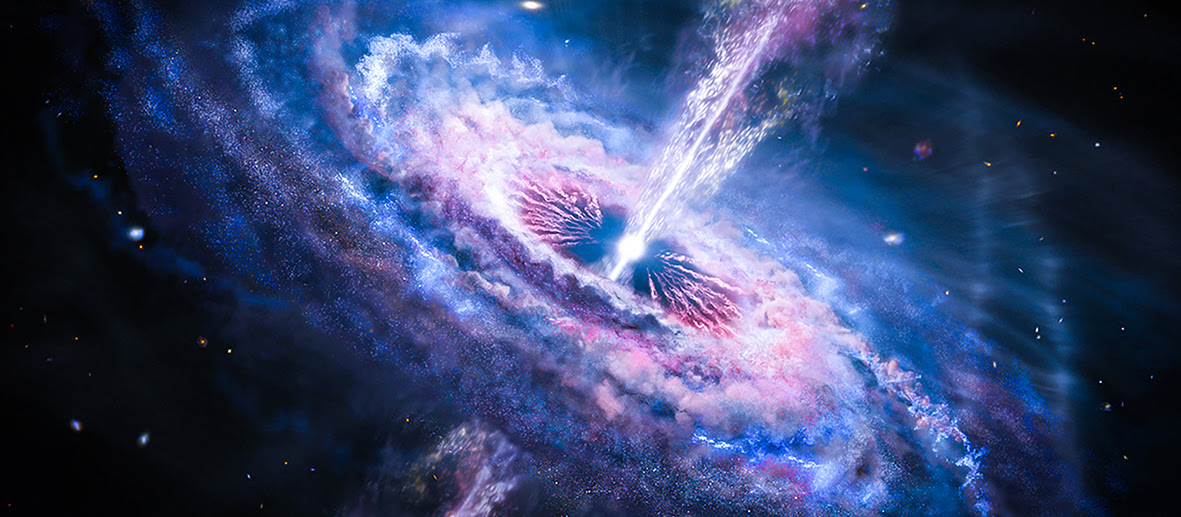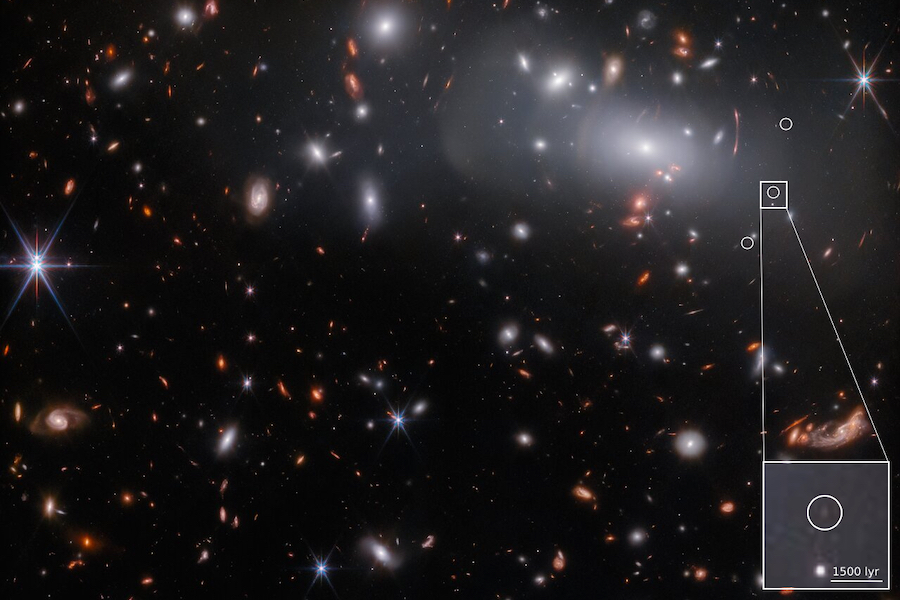An international team of researchers has made new observations of an unusual supernova, finding the most metal-poor stellar explosion ever observed.
Tag: Early Universe
Astronomers’ theory of how galaxies formed may be upended
The standard model for how galaxies formed in the early universe predicted that the James Webb Space Telescope (JWST) would see dim signals from small, primitive galaxies. But data are not confirming the popular hypothesis that invisible dark matter helped the earliest stars and galaxies clump together.
NSF NOIRLab Astronomers Discover the Fastest-Feeding Black Hole in the Early Universe
Using data from NASA’s JWST and Chandra X-ray Observatory, a team of U.S. National Science Foundation NOIRLab astronomers have discovered a supermassive black hole at the center of a galaxy just 1.5 billion years after the Big Bang that is consuming matter at a phenomenal rate — over 40 times the theoretical limit. While short lived, this black hole’s ‘feast’ could help astronomers explain how supermassive black holes grew so quickly in the early Universe.
DECam confirma que los vecindarios de los cuásares del Universo primitivo están realmente abarrotados
Observaciones realizadas con la Cámara de Energía Oscura (DECam, por sus siglas en inglés) confirman las expectativas de los astrónomos de que los cuásares del Universo primitivo se formaron en regiones del espacio densamente pobladas con galaxias compañeras. El enorme campo de visión de DECam y sus filtros especiales jugaron un papel fundamental para llegar a esta conclusión. Además, estas observaciones revelan la razón por la que los estudios previos que buscaban caracterizar la densidad de los vecindarios de los cuásares en el Universo primitivo arrojaban resultados contradictorios.
DECam Confirms that Early-Universe Quasar Neighborhoods are Indeed Cluttered
Observations using the Dark Energy Camera (DECam) confirm astronomers’ expectation that early-Universe quasars formed in regions of space densely populated with companion galaxies. DECam’s exceptionally wide field of view and special filters played a crucial role in reaching this conclusion, and the observations reveal why previous studies seeking to characterize the density of early-Universe quasar neighborhoods have yielded conflicting results.
Formation of super-Earths proven limited near metal-poor stars
In a new study, astronomers report novel evidence regarding the limits of planet formation, finding that after a certain point, planets larger than Earth have difficulty forming near low-metallicity stars.
Observatorio Gemini y Subaru unen fuerzas para descubrir la primera pareja de cuásares en el principio del Universo
Un equipo de astrónomos descubrió una pareja de cuásares en fusión que bate todos los récords, ya que no sólo se trata de la más distante detectada hasta ahora, sino también del único par de este tipo que se encuentra en una de las épocas más tempranas del Universo. El hallazgo fue posible con la ayuda del poderoso instrumento GNIRS que se encuentra instalado en el telescopio de Gemini Norte, la mitad boreal del Observatorio Internacional Gemini, financiado en parte por la Fundación Nacional de Ciencias de Estados Unidos y operado por NOIRLab de NSF.
International Gemini Observatory and Subaru Combine Forces to Discover First Ever Pair of Merging Quasars at Cosmic Dawn
With the help of the powerful GNIRS instrument on the Gemini North telescope, one half of the International Gemini Observatory, supported in part by the U.S. National Science Foundation and operated by NSF NOIRLab, a team of astronomers have discovered a double-record-breaking pair of quasars.

A Long, Long Time Ago in a Galaxy Not So Far Away…
Employing massive data sets collected through NASA’s James Webb Space Telescope, a research team led by a Rutgers University–New Brunswick astronomer is unearthing clues to conditions existing in the early universe. The team has catalogued the ages of stars in the Wolf–Lundmark–Melotte (WLM) galaxy, constructing the most detailed picture of it yet, according to the researchers.
Gas on the run
Theoretical predictions have been confirmed with the discovery of an outflow of molecular gas from a quasar when the Universe was less than a billion years old.

Quasar ‘clocks’ show Universe was five times slower soon after the Big Bang
Scientists have for the first time observed the early universe running in extreme slow motion, unlocking one of the mysteries of Einstein’s expanding universe.
Researchers discover chemical evidence for pair-instability supernova from a very massive first star
The first stars illuminated the Universe during the Cosmic Dawn and put an end to the cosmic “dark ages” that followed the Big Bang. However, the distribution of their mass is one of the great unsolved mysteries of the cosmos.

Astronomers find distant gas clouds with leftovers of the first stars
Using ESO’s Very Large Telescope (VLT), researchers have found for the first time the fingerprints left by the explosion of the first stars in the Universe. They detected three distant gas clouds whose chemical composition matches what we expect from the first stellar explosions.

Researchers discover tiny galaxy with big star power using James Webb telescope
Using first-of-their-kind observations from the James Webb Space Telescope, a University of Minnesota Twin Cities-led team looked more than 13 billion years into the past to discover a unique, minuscule galaxy that could help astronomers learn more about galaxies that were present shortly after the Big Bang.
Were galaxies much different in the early universe?
An array of 350 radio telescopes in the Karoo desert of South Africa is getting closer to detecting “cosmic dawn” — the era after the Big Bang when stars first ignited and galaxies began to bloom.
Non-detection of key signal allows astronomers to determine what the first galaxies were – and weren’t – like
Researchers have been able to make some key determinations about the first galaxies to exist, in one of the first astrophysical studies of the period in the early Universe when the first stars and galaxies formed, known as the cosmic dawn.
ALMA Scientists Detect Signs of Water in a Galaxy Far, Far Away
Scientists studying SPT0311-58 found H20, along with carbon monoxide in the galaxy, which is located nearly 12.88 billion light years from Earth. Detection of these two molecules in abundance suggests that the molecular Universe was going strong shortly after the elements were forged in early stars.
Hubble Finds Early, Massive Galaxies Running on Empty
Fast and furious—that’s how six massive galaxies in the early universe lived before they literally ran out of gas, shut down star formation, and died. These images are composites from Hubble and ALMA.
How to catch a perfect wave: Scientists take a closer look inside the perfect fluid
Scientists have reported new clues to solving a cosmic conundrum: How the quark-gluon plasma – nature’s perfect fluid – evolved into the building blocks of matter during the birth of the early universe.
Key to Carbon-Free Cars? Look to the Stars
In a decade-long quest, scientists at Berkeley Lab, the University of Hawaii, and Florida International University uncover new clues to the origins of the universe – and land new chemistry for cleaner combustion engines

Ceramic chips inside meteorites hint at wild days of the early solar system
A new analysis of ceramic chips embedded in meteorites suggests the formation of our solar system was not as quiet and orderly as we once thought.

Featured Video: Rotating Galaxy Disks in the Early Universe
Host Melissa Hoffman of the National Radio Astronomy Observatory talks about how ALMA discovered a young galaxy and what it tells us about our own Milky Way.”
Quasar Discovery Sets New Distance Record
Astronomers have discovered the most distant quasar yet found. The quasar is seen as it was only 670 million years after the Big Bang, and is providing valuable clues about how huge black holes and their host galaxies formed in the early Universe.